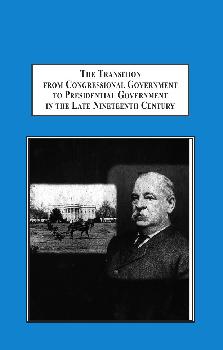Transition From Congressional Government to Presidential Government in the Late Nineteenth Century. The Key Role of Grover Cleveland in the Process
We are currently unable to ship to the EU countries at this time. We apologize for this inconvenience.

| Author: | Steinfeldt, Andrew | |
| Year: | 2012 | |
| Pages: | 180 | |
| ISBN: | 0-7734-3066-0 978-0-7734-3066-2 | |
| Price: | $159.95 + shipping | |
| (Click the PayPal button to buy) | ||
The book argues that the imperial presidency began, not with Franklin Delano Roosevelt, but rather with Grover Cleveland. The role of the president was enlarged, and the role of congress diminished during his time in office.
Once the concept of the modern presidency is clearly defined according to its attributes, it becomes clear that it has evolutionary roots that extend to the late 19th century. An examination of Grover Cleveland’s presidencies shows that he laid the foundation for what has become the modern presidency by actions that took place during his two separated terms. He implemented civil service reform and scaled back the number of patronage appointments significantly, took steps towards building a professional bureaucracy. He also regained the independence of the presidency by pressuring Congress to repeal the Tenure of Office Act, and pioneered the form of political leadership that presidents exhibit today.
Once the concept of the modern presidency is clearly defined according to its attributes, it becomes clear that it has evolutionary roots that extend to the late 19th century. An examination of Grover Cleveland’s presidencies shows that he laid the foundation for what has become the modern presidency by actions that took place during his two separated terms. He implemented civil service reform and scaled back the number of patronage appointments significantly, took steps towards building a professional bureaucracy. He also regained the independence of the presidency by pressuring Congress to repeal the Tenure of Office Act, and pioneered the form of political leadership that presidents exhibit today.
Reviews
“If we can understand the trends that Cleveland set into motion we can better understand the terms on which future transformations are likely to take place.”
-Prof. Daniel Klinghard,
College of the Holy Cross
“The value of this work is that Steinfeldt expands the definition of modern presidencies beyond the early to mid-twentieth century.”
-Prof. David Kanervo,
Austin Peay University
“…advances our understanding of the evolution of the U.S. executive power and links it with the social and economic ferment of the post-Reconstruction era… an original and provocative contribution to the scholarship of the modern Presidency.”
-Prof. Sean K. Anderson,
Idaho State University
-Prof. Daniel Klinghard,
College of the Holy Cross
“The value of this work is that Steinfeldt expands the definition of modern presidencies beyond the early to mid-twentieth century.”
-Prof. David Kanervo,
Austin Peay University
“…advances our understanding of the evolution of the U.S. executive power and links it with the social and economic ferment of the post-Reconstruction era… an original and provocative contribution to the scholarship of the modern Presidency.”
-Prof. Sean K. Anderson,
Idaho State University
Table of Contents
Forward i
Preface v
Chapter 1—Introduction 1
Chapter 2—Defining the Modern Presidency 9
Franklin D. Roosevelt, the Modern President—Modern
Presidents before FDR—The Imperial Presidency—The Postmodern Presidency—A Useful Definition of the Modern Presidency
Chapter 3—Franklin D. Roosevelt’s Presidency 28
FDR’s Progressive Ideology—Roosevelt’s Reform
Initiatives—Rethinking Reform—Response to Opposition—Previous Reform Efforts—Foreign Policy Leadership—FDR’s Contribution to the Modern Presidency
Chapter 4—The Economic, Social, and Political
Environment of the Post Civil War Era 61
Industrialization and Corporatization—Creating a Corporate Commonwealth—Government Corporatization and the Spoils System—Attempts at Civil Service Reform—Social and Economic Changes—The Populist Movement—The
Granger Movement—The Organization of Labor—The Progressive Movement—The Financial Crisis of 1873—Effect on the Legislative Branch
Chapter 5—Grover Cleveland’s Rise to Political
Prominence 85
Integrity and Sense of Responsibility—Mayor of Buffalo—Governor of New York—Protecting the Interests of the Working Class—Facing the Problems of the Gilded Age—Resistance to the Boss System and Patronage—Election to the Presidency—Cleveland’s Election Signals a Shift in Public Expectations
Chapter 6—The Presidencies of Grover Cleveland 104
Protecting the Public Interest—Restructuring Government—Protecting Federal Lands—Administrative Reform—Battle over the Removal Power—The Tenure of Office Act—Cleveland Challenges the Tenure of Office Act—The Senate Resists—Repeal of the Tenure of Office Act—Independence of the Presidency—Expansion of Executive Authority—Economic Issues—Foreign Affairs—Cleveland’s Legacy
Chapter 7—Conclusion 136
Bibliography 143
Index 154
Preface v
Chapter 1—Introduction 1
Chapter 2—Defining the Modern Presidency 9
Franklin D. Roosevelt, the Modern President—Modern
Presidents before FDR—The Imperial Presidency—The Postmodern Presidency—A Useful Definition of the Modern Presidency
Chapter 3—Franklin D. Roosevelt’s Presidency 28
FDR’s Progressive Ideology—Roosevelt’s Reform
Initiatives—Rethinking Reform—Response to Opposition—Previous Reform Efforts—Foreign Policy Leadership—FDR’s Contribution to the Modern Presidency
Chapter 4—The Economic, Social, and Political
Environment of the Post Civil War Era 61
Industrialization and Corporatization—Creating a Corporate Commonwealth—Government Corporatization and the Spoils System—Attempts at Civil Service Reform—Social and Economic Changes—The Populist Movement—The
Granger Movement—The Organization of Labor—The Progressive Movement—The Financial Crisis of 1873—Effect on the Legislative Branch
Chapter 5—Grover Cleveland’s Rise to Political
Prominence 85
Integrity and Sense of Responsibility—Mayor of Buffalo—Governor of New York—Protecting the Interests of the Working Class—Facing the Problems of the Gilded Age—Resistance to the Boss System and Patronage—Election to the Presidency—Cleveland’s Election Signals a Shift in Public Expectations
Chapter 6—The Presidencies of Grover Cleveland 104
Protecting the Public Interest—Restructuring Government—Protecting Federal Lands—Administrative Reform—Battle over the Removal Power—The Tenure of Office Act—Cleveland Challenges the Tenure of Office Act—The Senate Resists—Repeal of the Tenure of Office Act—Independence of the Presidency—Expansion of Executive Authority—Economic Issues—Foreign Affairs—Cleveland’s Legacy
Chapter 7—Conclusion 136
Bibliography 143
Index 154
Other American Presidency Books
2007 - Impact of Franklin Pierce on Nathaniel Hawthorne: Friendship, Politics, and the Literary Imagination
>> See all our American Presidency books